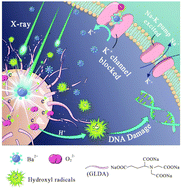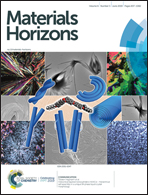Radiation-assisted metal ion interference tumor therapy by barium peroxide-based nanoparticles†
Abstract
In high-Z element enhanced radiotherapy strategies, the clinical potential of metal-based nanocomposites is always reduced by the serious side effects of leaked heavy metal ions. In this study, we demonstrate a novel anticancer strategy to realize controllable cytotoxicity of metal elements with the aid of high-energy radiation, based on a design of chelator-modified barium peroxide nanoparticles (GL-BaO2 NPs). Free Ba2+ is a potassium channel inhibitor that inhibits cell proliferation. The chelator modification can strongly bind leaked free Ba2+, thus reducing its unwanted side effects in normal tissues. However, under X-ray radiation in tumor regions, the produced hydroxyl radicals will break the chemical structures of chelators. Consequently, the released Ba2+ can access the membrane without a barrier and contribute to tumor treatment. More importantly, the sensitization of Ba in the lattice of barium peroxide will directly transform peroxide groups into reactive hydroxyl radicals, which further guarantees the decomposition of chelators as well as the efficient killing of cells. This strategy, which we termed ion interference therapy, demonstrates a universal paradigm by employing the biological effects of metal ions in tumor treatment, revealing its industrial potential for radiotherapy enhancement.



 Please wait while we load your content...
Please wait while we load your content...